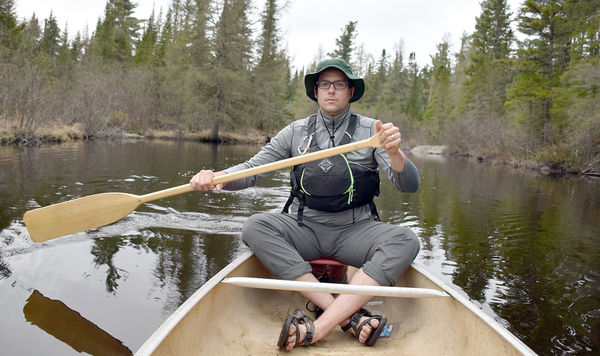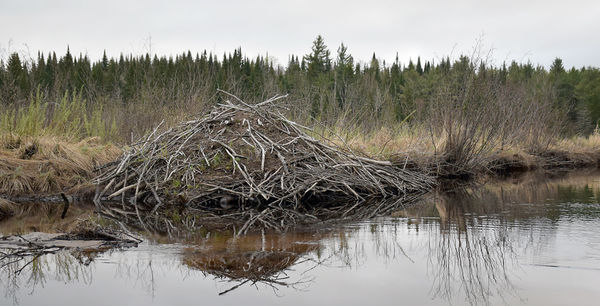Smooth sailing after early wake-up call

Jason Labonte, of Saranac Lake, navigates during a canoe trip up the North Branch of the Saranac River near Onchiota. News photo — Justin A. Levine
It was still dark when Jason texted me “In the driveway.” We’d each been up for almost an hour, and I was kind of miserable because we were out of coffee. A 4:45 a.m. start time requires just two things: caffeine and a friend silly enough to agree to such an early start time.
The chai I made started to course its way through my veins as we drove toward Onchiota. Within a few minutes we were pulling into the still-closed Buck Pond Campground, operated by the state Department of Environmental Conservation, for an early morning outing on the water.
The plan was to put in on Lake Kushaqua and head into the Rainbow Narrows. From there, we would either go into Rainbow Lake or do a little exploring on the North Branch of the Saranac River.
The water was glassy smooth, and as we neared the 114-year-old tunnel that goes under the old railroad bed, the only sign of life we’d seen was a boat and tent at one of the primitive campsites. A solitary loon then flew overhead, making its classic call and joining in with the chorus of songbirds that were singing away all around us.
Jason had never been on this paddle, and wanting a little adventure, we turned right into the mouth of the river just after going under Mud Pond-Kushaqua Road. I’d been up the river a little ways on a few occasions, but within a few minutes we were already upstream of my usual turnaround point.

In just about three miles of canoeing, there were a half-dozen beaver houses in various states of use. News photo — Justin A. Levine
The birds kept singing and we scared off a duck a few times as we rounded bends in the winding river. About two miles into the paddle, the smell of the air changed, as did the scenery. We were no longer on a river winding through a forest thick with the smell of pine, but venturing into the heart of a dank-smelling bog.
Talking quietly as we paddled against the easy current, a flash of movement caught our eyes as a bald eagle that had been flying our way turned and glided back to a gnarly spruce across the bog. To our surprise, the eagle didn’t land in the tree. Another eagle flew out and the pair circled leisurely through the air as they moved away from us. Unfortunately, that would be the last of the eagles we saw.
We came to the first real beaver dam (the first of six we would hit before turning around) and pulled out on the grassy hammock to the right of the river, which was really more of a stream at this point. Carrying the canoe maybe 50 feet around the dam, we relaunched and continued on.
In the next mile, as the stream narrowed and was, in turns, deep and dark or wide and shallow, we passed over another five beaver dams, as well as the remnants of long gone dams or trees that created shallow riffles across the waterway, but the first dam was the only one we had to get out of the boat to navigate. In addition to the dams, there were a half-dozen beaver houses, some no doubt long abandoned, but impressive structures nonetheless.
The main channel of the river is relatively easy to follow as the current is weak but apparent in most places. The dams upstream of the first were easy to push through, though I’m not sure I would want to do that if the paddles were expensive, since some pushing off the dams was required.
As the stream tapered, more and more little branches shot off the sides and into the bog. Although the channel was still apparent, it would have been fun to be in kayaks to be able to navigate a few little side trips.
Finally, since the stream had been only about a foot deep for a while, the sun was up and we both wanted to be home by 8 a.m. or so, we hit a beaver dam that was still quite intact and held the stream back by a few inches. It seemed like as good as any a place to turn around and head back.
I pulled out a notebook to track how many beaver dams and houses we passed, and we talked about how weird it was that we hadn’t seen any actual beaver. Jason and I were also disappointed there were no moose sightings, as it seems prime country for the Adirondacks’ largest mammal.
Moving with the current again, we paddled just to steer and were able to paddle/push our way over all of the dam we encountered, including the one we had carried around on the way in. We’re lucky that a late May paddle still represents pretty high water, and doing this stretch of river in a delicate boat or during the height of summer might require a little more walking. Luckily, most of the dams were in shallow spots, so dragging a boat over them might only require a few steps in the stream itself.
As we got closer to the mouth of the river and Rainbow Narrows, we saw a single raven, the poor duck we had scared on our way in and any number of little warblers and songbirds, none of which either of us could identify. It appeared our encounter with the eagles would be the pretty much it.
There is an island in the middle of the river, maybe a quarter-mile upstream from the Rainbow Narrows. We drifted past, having paddled around the far side on our way in, and just as we reached the spot in the river where the two channels re-converged, I caught a glimpse of movement to the right and then heard and saw a large splash.
“Beaver!” Jason said excitedly, and for sure, a beaver had seen us and slapped the surface before disappearing under the water. We stopped paddling and just drifted for a minute to see if it would resurface, but if it did, we couldn’t see it.
It seemed a fitting end that a paddle defined by beaver houses and dams would end with a surprising slap of the tail.
- In just about three miles of canoeing, there were a half-dozen beaver houses in various states of use. News photo — Justin A. Levine






